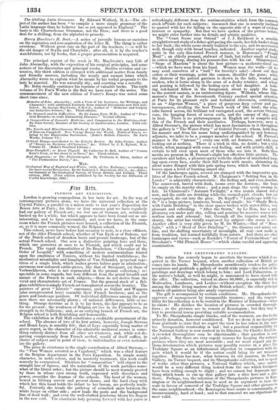THE SHEEPSHANKS GALLERY.
The nation has scarcely begun to ascertain the treasure which it ac- quired in the Turner bequest, when another collection of British art comes into its hands. Mr. Sheepshanks munificently tenders for public acceptance and gratitude a gallery of world-wide name—the whole of the paintings and drawings which belong to him ; and Lord Palmerston, on the nation's behalf, as well he might, is announced to have closed with the offer. The collection, valued at above 60,0001., is especially rich in Mulreadies, Landseers, and Leslies—without exception the three best among the elder living masters of the British school ; the other principal modern oil-painters being also amply represented.
The gift is accompanied by certain conditions. Mr. Sheepshanks dis- approves of management by irresponsible trustees ; and the responsi- bility for his collection is to be vested in the Minister of Education—when he exists ? He dislikes the location of pictures in crowded thorough- fares ; so the pictures are to remain at Kensington; but they may be lent to provincial towns providing suitable accommodation. To Mr. Sheepshanks simple thanks, and of the warmest, are due for his princely donation, however conditioned. Yet we deem it no derogation from gratitude to state that we regret the view he has taken in the mat- ter. Irresponsible trusteeship is bad ; but a practical responsibility for the National Gallery is now centred in its Director, Sir Charles Eastlake. A crowded thoroughfare may be objectionable ; that question is now sub judice. But there are very cogent reasons for keeping the national pictures where they are most accessible ; and we must regard any du- bious deterioration which pictures may possibly receive in a place like Trafalgar Square as an infinitesimal objection in comparison with the gain which it would be if the nation could bring its art treasures together. Britain has now, what between its old masters, its Vernon Gallery, its Turner bequest, and its Sheepshanks collection, not to speak of works other than pictures, a National Gallery which, once united, would be a very different thing indeed from the one which foreigners have been willing enough to slight ; and we cannot but deprecate ally- thing which tends to cut up that gallery into a slice here and a slice there. Perhaps, too, the retention of the Sheepshanks pictures in Ken- sington or its neighbourhood may be used as an argument to turn the scale in favour of removal of the Trafalgar Square and other pictures to the same neighbourhood—the Kensington Gore estate is conveniently, or inconveniently, hard at hand ; and to that removal we see objections the most valid.
































 Previous page
Previous page